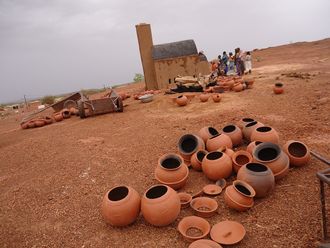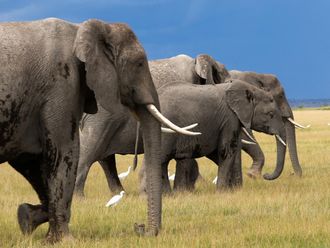
Laikipia, Kenya: Machete in hand, Kenyan farmer Paul Njoroge points at the broken branches and giant footprints where elephants trampled his bananas, maize, potatoes and sugar cane.
“We don’t hate the elephants, but their activities are making us poor,” said the 53-year old farmer, surveying his lush green fields, a five-hectare (12-acre) plot on the slopes of the Laikipia highlands in central Kenya.
“I have this big farm but yet sometimes I have to go for food handouts from the government.”
While poachers slaughter thousands of elephants across Africa each year, competition between elephants and people over land is a far bigger problem in the long run, conservationists say.
To help combat that, a 163-km electric fence is being erected to provide a separation zone between farmland and elephant migration routes.
Max Graham, from the Space for Giants conservation group leading the fence construction, believes it will improve safety for people and crops, protect the endangered animals from poachers, and ease pressure on grassland from farmers who sneak in livestock illegally to graze in areas reserved for wildlife.
“This is the front line separating smallholder agriculture from elephant conservation,” Graham said.
“While the elephant poaching crisis is a massive emergency problem, human-elephant conflict over the long term is going to be the single biggest issue for elephant conservation in Africa.”
Laikipia, a 10,000 sq km rangeland at the base of snowcapped Mount Kenya, some 200km north of the capital Nairobi, has the second-largest density of wildlife in Kenya after the world-famous Maasai Mara reserve.
The vast plateau is home to some 6,300 elephants — as well as farmers trying to earn a living from the same lands. Conservationists record as many as 10 incidents of human-elephant conflict a day.
Conservationists argue that protecting the elephants will also help boost the tourist industry, which in this area employs thousands of Kenyans and brings in some $20 million (18 million euros) in revenue a year.
The $870,000 (Dh3.19million) fence, funded by cash raised during a recent summit meeting in April to stem ivory poaching, is not cheap.
But it is hoped it will help end the more than $1 million worth of crops damaged by elephants every year.
Njoroge’s losses alone totalled more than $4,000 over the past year.
Kenya’s environment minister Judi Wakhungu says that compensation funds are overstretched, meaning rarer cases where people have been killed are given priority.
And without compensation from the government, the worst hit farmers can see poaching as an alternative to survive.
“Poaching is a problem, yes, but the biggest challenge we face in terms of wildlife conservation, is finding space for wildlife,” said Wakhungu.
“As our human population grows, there’s a lot of pressure to develop facilities and infrastructure.”
In the past, rickety old fences were easily broken down by elephants hungry for the farmers’ harvests.
When the elephants came, villagers would gather together, lighting fires and beating drums to scare them away, but to little effect.
Other methods have been tried: including smearing rope fences with chili paste, or burning chili mixed with elephant dung, methods that are not feasible over long distances.
The new fence carries a 7,000 volt pulsing electric shock, with dangling metre-long wire strips, to stop the elephants well before they can use their tusks to uproot posts as they did in the past.
“What it means is no more lost crops, a better income, and a better chance to pay for important things like school for my children,” Njoroge said.
More than 20 people in the district have died in battles with elephants in the past two years, he said.
“We will continue to live here,” he said. “We bury our neighbours and life is returning.”












